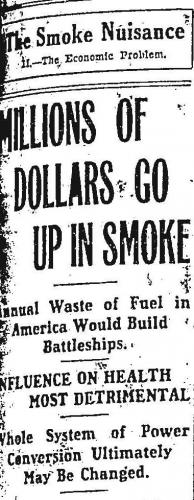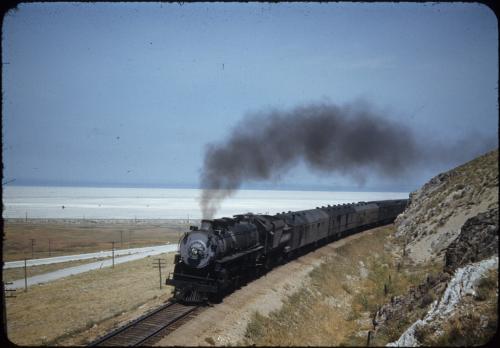Environment and Economy
Throughout Utah’s history, business interests, policymakers, and civic organizations have sought to balance economic growth with environmental stewardship. As early as the 1880s, the Salt Lake business community recognized that the city’s poor air quality was a major obstacle to economic growth. An 1893 editorial in the Salt Lake Herald-Republican observed, “Salt Lake has as much to expect from the increase she will receive from persons who will select it as their residence on account of its pure air and cleanliness as it has to gain from factories.” In the early twentieth century, the scope of the challenge became clear as described by the Salt Lake Telegram in 1912 who published a 6-part series on air quality. Part 2 focused on the "Economic Problem" with the headline "Millions of Dollars go up in Smoke" due to incomplete combustion of coal. It also noted that health impacts of air pollution were severe and our "whole system of power conversion ultimately may be changed."
Around this time, urban beautification efforts were undertaken across the country, often with collaborating groups interested in different outcomes. For example, the Utah Federation of Women's Clubs pushed to improve the city in the early 1900s, but whereas the women were interested in improving the urban environment for its own sake, the Salt Lake City's Women's Chamber of Commerce was focused on advertising a “clean” Salt Lake for business and tourism. Important studies of air pollution were conducted in Salt Lake during the 1920s, and regulations led to some improvement in air quality, but some of these gains were reversed as funding for enforcement dried up in the latter part of the decade.
When the Salt Lake Women’s Chamber of Commerce was formed in 1936 to advocate for policies that would bring about a “smokeless city,” the balance between economics and environmental stewardship took on new dimensions. The Women’s Chamber argued that the municipal power structure was beholden to eastern capital and railroad interests that exploited Utah and polluted its skies. They promoted the construction of a coal-processing plant where natural gas and oil could be extracted from Utah’s bituminous coal, creating a “smokeless” anthracite coal and valuable byproducts that would pay for the cost of the facility. Under this plan, they claimed, Salt Lake could achieve clear skies and economic independence simultaneously. Although their proposals were never fully adopted, they consulted regularly with municipal leaders and remained a force in city politics. When the attack on Pearl Harbor occurred, the nation and Utah prioritized industrial steel production for national defense at the expense of temporarily worsened air quality in Utah.
In the postwar period, growing adoption of natural gas for home heating displaced residential coal combustion, but there was continued public attention on industrial pollution and vehicles also became a dominant source of pollution. New state and federal regulations spurred innovation, like the invention of the catalytic converter, that have over time resulted in reduced vehicle emissions. The Geneva Steel plant was a notable source of industrial pollution in Utah. The plant temporarily closed in winter of 1986–1987 due to a labor strike which created a natural experiment that illustrated the negative public health impact its operation had on the surrounding community.
In 1990, Governor Bangeter noted the importance of balancing environmental stewardship and economic development, telling the Provo Daily Herald "I think we can have both." He formed a Clean Air Commission to investigate the issue and they noted that technology to reduce air pollution well below federal standards was not yet technically or economically viable, and so Utah's policy choice by default was to work towards meeting federal air quality standards. Today, the situation is rapidly changing as we're seeing innovation driving down clean energy costs and economic development in many areas will lead to reduced emissions.
Looking back through Utah's history it has been clear that continued efforts in environmental stewardship has been essential for the state's economic growth, and will remain true in the future.




